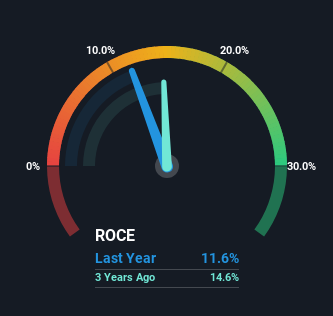- United Arab Emirates
- /
- Food and Staples Retail
- /
- DFM:UNIONCOOP
Union Coop (DFM:UNIONCOOP) Is Finding It Tricky To Allocate Its Capital
To avoid investing in a business that's in decline, there's a few financial metrics that can provide early indications of aging. Businesses in decline often have two underlying trends, firstly, a declining return on capital employed (ROCE) and a declining base of capital employed. Basically the company is earning less on its investments and it is also reducing its total assets. Having said that, after a brief look, Union Coop (DFM:UNIONCOOP) we aren't filled with optimism, but let's investigate further.
Return On Capital Employed (ROCE): What Is It?
If you haven't worked with ROCE before, it measures the 'return' (pre-tax profit) a company generates from capital employed in its business. Analysts use this formula to calculate it for Union Coop:
Return on Capital Employed = Earnings Before Interest and Tax (EBIT) ÷ (Total Assets - Current Liabilities)
0.12 = د.إ334m ÷ (د.إ3.4b - د.إ539m) (Based on the trailing twelve months to June 2023).
So, Union Coop has an ROCE of 12%. In absolute terms, that's a satisfactory return, but compared to the Consumer Retailing industry average of 8.7% it's much better.
See our latest analysis for Union Coop

Historical performance is a great place to start when researching a stock so above you can see the gauge for Union Coop's ROCE against it's prior returns. If you want to delve into the historical earnings, revenue and cash flow of Union Coop, check out these free graphs here.
So How Is Union Coop's ROCE Trending?
We are a bit worried about the trend of returns on capital at Union Coop. Unfortunately the returns on capital have diminished from the 15% that they were earning three years ago. On top of that, it's worth noting that the amount of capital employed within the business has remained relatively steady. Since returns are falling and the business has the same amount of assets employed, this can suggest it's a mature business that hasn't had much growth in the last three years. So because these trends aren't typically conducive to creating a multi-bagger, we wouldn't hold our breath on Union Coop becoming one if things continue as they have.
Our Take On Union Coop's ROCE
All in all, the lower returns from the same amount of capital employed aren't exactly signs of a compounding machine. Investors must expect better things on the horizon though because the stock has risen 5.9% in the last year. Either way, we aren't huge fans of the current trends and so with that we think you might find better investments elsewhere.
On a separate note, we've found 2 warning signs for Union Coop you'll probably want to know about.
While Union Coop isn't earning the highest return, check out this free list of companies that are earning high returns on equity with solid balance sheets.
New: AI Stock Screener & Alerts
Our new AI Stock Screener scans the market every day to uncover opportunities.
• Dividend Powerhouses (3%+ Yield)
• Undervalued Small Caps with Insider Buying
• High growth Tech and AI Companies
Or build your own from over 50 metrics.
Have feedback on this article? Concerned about the content? Get in touch with us directly. Alternatively, email editorial-team (at) simplywallst.com.
This article by Simply Wall St is general in nature. We provide commentary based on historical data and analyst forecasts only using an unbiased methodology and our articles are not intended to be financial advice. It does not constitute a recommendation to buy or sell any stock, and does not take account of your objectives, or your financial situation. We aim to bring you long-term focused analysis driven by fundamental data. Note that our analysis may not factor in the latest price-sensitive company announcements or qualitative material. Simply Wall St has no position in any stocks mentioned.
About DFM:UNIONCOOP
Union Coop
Union Coop establishes and manages hypermarkets and consumer cooperatives in the United Arab Emirates.
Excellent balance sheet average dividend payer.
Market Insights
Community Narratives



